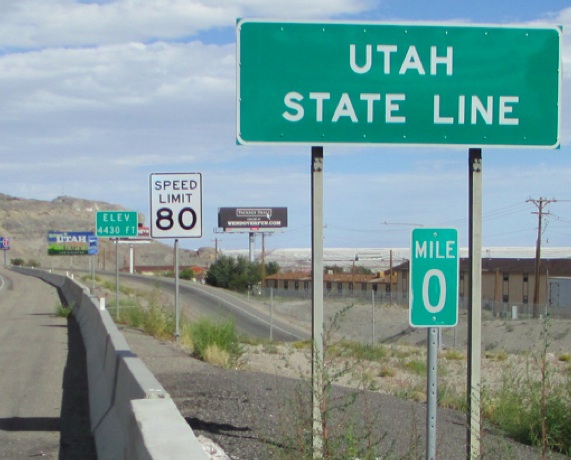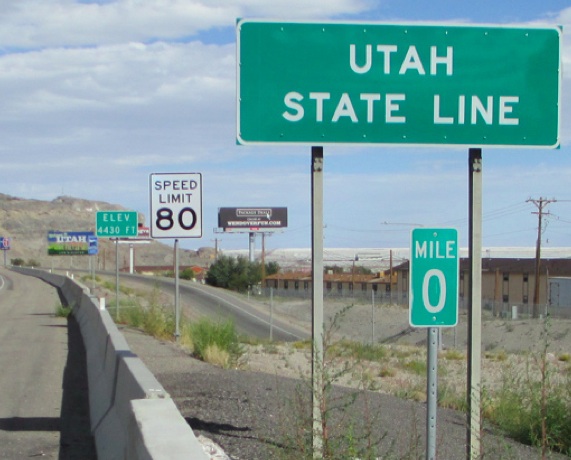For the first time since Richard Nixon occupied the Oval Office it is now legal to drive 80 miles an hour on Interstate 80 from Wendover most of the way to Salt Lake City.
The new limit and its accompanying signs went up over the weekend replacing the old 75 mph’s which replaced the 65 mph limit about ten years ago. The 65 mph limit replaced the 55 mph limit set in 1974 in response to the Arab oil embargo against the United States.
The Emergency Highway Energy Conservation Act was a bill in the U.S. Congress that enacted the National Maximum Speed Law. States had to agree to the limit if they desired to receive federal funding for highway repair. The uniform speed limit was signed into law by President Nixon on January 2, 1974, and became effective 60 days later, by requiring the limit as a condition of each state receiving highway funds, a use of the Commerce Clause of the United States Constitution.
The legislation required 55 mph speed limits on all four-lane divided highways unless the road had a lower limit before November 1, 1973. In some cases, like the New York Thruway, the 50 mph speed limit had to be raised to comply with the law. The law capped speed limits at 55 mph on all other roads.
 While the law was intended to save oil the end result was negligible. While experts assured Congress that the slower speed would save about 15 percent of oil supplies in reality the savings were between 1.0 and 0.5 percent.
While the law was intended to save oil the end result was negligible. While experts assured Congress that the slower speed would save about 15 percent of oil supplies in reality the savings were between 1.0 and 0.5 percent.
A major reason for the disparity between the projections and the facts was simple, most drivers broke the law. According to study after study compliance with the 55 ‘double nickel’ speed limit was at best 20 percent even in heavily trafficked urban ares and fell below 10 percent on rural stretches of the Interstate system.
But while the double nickel did not save gas it did create a whole new source of revenue for states in the form of speeding tickets. For the 14 years the double nickel was in effect billions of dollars poured into state and local coffers in the form of fines and bail forfeitures.
In 1988 Congress allowed states to increase the limit to 65 mph on some sections of the Interstate despite heavy opposition both from some states who feared the loss of revenue and also from automobile safety groups which argued the 55 mph limit saved lives.
 According to the National Research Council, there was a decrease in fatalities of about 4000 lives in the first year after the law took effect. Later, the National Academies wrote that is, “a strong link between vehicle speed and crash severity supports the need for setting maximum limits on high-speed roads,” but that, “the available data do not provide an adequate basis for precisely quantifying the effects that changes in speed limits have on driving speeds, safety, and travel time on different kinds of roads.” They also note that on rural interstates, the free flowing traffic speed should be the major determinant of the speed limit because, “Drivers typically can anticipate appropriate driving speeds.” This is due, in part, to the strong access control in these areas but also is an acknowledgement of the difficulty of enforcing speed laws in these areas.
According to the National Research Council, there was a decrease in fatalities of about 4000 lives in the first year after the law took effect. Later, the National Academies wrote that is, “a strong link between vehicle speed and crash severity supports the need for setting maximum limits on high-speed roads,” but that, “the available data do not provide an adequate basis for precisely quantifying the effects that changes in speed limits have on driving speeds, safety, and travel time on different kinds of roads.” They also note that on rural interstates, the free flowing traffic speed should be the major determinant of the speed limit because, “Drivers typically can anticipate appropriate driving speeds.” This is due, in part, to the strong access control in these areas but also is an acknowledgement of the difficulty of enforcing speed laws in these areas.
During the time the law was enacted and after it was repealed automobile fatalities decreased, and this was widely attributed mainly to automobile safety improvements, owing to an increase in the safety of cars themselves. This decrease in fatalities from automobile accidents makes figuring out the actual impact of the law difficult.
In other words if the relatively low speed limit is almost universally ignored how can it be credited with saving lives?
 That reasoning also helped propel the compleat repeal of the national speed limit in 1996. Western states such as Nevada and Utah quickly moved to increase the limit to 75 mph and in the spring of 2013 Utah announced that it would return sections of its Interstate system back to 80 mph of 40 years ago including I-80 from Grantsville (exit 99) to Wendover, on the Utah-Nevada border; I-84 from Tremonton to the Utah-Idaho border; I-15 from Brigham City (North interchange) to the Utah-Idaho border; and I-15 from Santaquin to North Leeds.
That reasoning also helped propel the compleat repeal of the national speed limit in 1996. Western states such as Nevada and Utah quickly moved to increase the limit to 75 mph and in the spring of 2013 Utah announced that it would return sections of its Interstate system back to 80 mph of 40 years ago including I-80 from Grantsville (exit 99) to Wendover, on the Utah-Nevada border; I-84 from Tremonton to the Utah-Idaho border; I-15 from Brigham City (North interchange) to the Utah-Idaho border; and I-15 from Santaquin to North Leeds.
While 80 mph speed limit has returned the price of a gallon of gas is higher than the mid-70’s even accounting for inflation. A gallon of gas in 1974 averaged 53 cents a gallon of $2.94 in today’s dollars. However since fuel efficiency has risen from less that 15 miles per gallon to well over 30 m.p.g. on average it is actually cheaper to make the Wendover Salt Lake drive and now just as fast.


